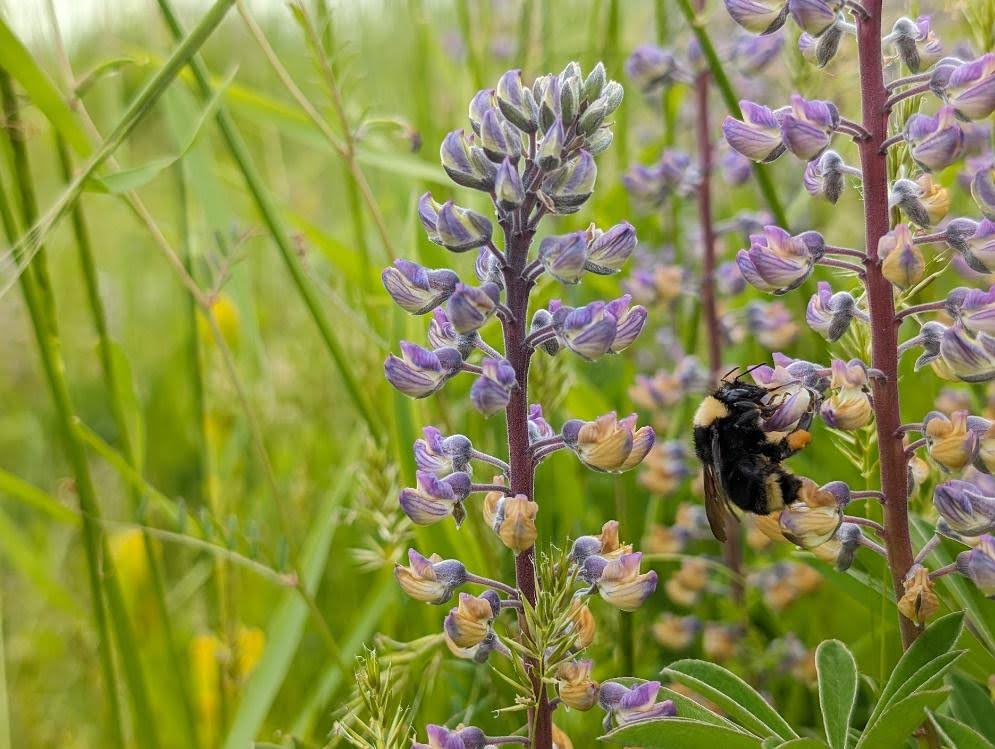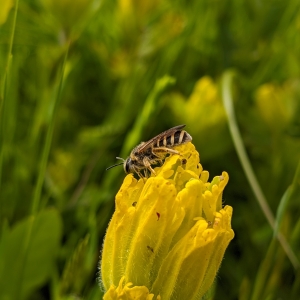By Claire Rubens, September 2024
Since 2019, the Institute for Applied Ecology has studied the interactions of plants and their insect pollinators in Willamette Valley prairies, with a special focus on Willamette daisy (Erigeron decumbens), Kincaid’s lupine (Lupinus oreganus) and golden paintbrush (Castilleja levisecta). Equipped with quadrats, insect nets, and plastic spoons, the 2024 pollinator crew set out to accomplish three main objectives this season:
- Re-survey forb communities to quantify floral resources for pollinators at five sites along the Willamette Valley
- Continue plant and pollinator network surveys to better understand relationships between insect pollinators, our focal plant species, and the surrounding forb communities
- Determine the most efficient and effective methods of hand pollinating Kincaid’s lupine and golden paintbrush, and perform pollen supplementation trials in four populations to determine if pollen limitation may be a factor in their conservation status


New and exciting additions to our fieldwork this season were pollen supplementation trials of Kincaid’s lupine and golden paintbrush. Previously, similar trials were conducted with Willamette daisy but these methods needed to be adapted to suit the different flower structures. Perfecting this skill was one of the greatest challenges of the field season, but we learned from the best! Slowing down during the busy field season and making time to observe the ways in which the bees manipulate flowers of our focal species was key to our success.
Based on Christina Mitchell’s preliminary work last season, we found that forceps were the most useful tool to access the anthers of the more robust golden paintbrush flowers. Black plastic spoons and our own hands were the tools of choice for the delicate and complex structures of lupine flowers. With the dark, smooth surface of the spoon we were better able to keep track of the minute amounts of light-colored pollen that we collected from our donor plants. We then transported this precious pollen to the recipient plants.

We pollinated each individual flower on lupine stalks, using one hand to expose the stigma and the other to delicately scrape pollen from the surface of the spoon to the head of the stigma. This work required extreme patience and dexterity, and was only made more difficult by the intense heat that comes with prairie field work. Later in the season the seeds were collected from each hand-pollinated stalk and counted to determine if seed set increased with hand pollination. Using all that we learned this season, we plan to scale up these trials next year to include more individual plants at each site.
With recent visits to the Oregon State Arthropod Collection and the Oregon Bee Atlas lab, we were able to make considerable progress on the species level identification of bee specimens in IAE’s collection. Some notable highlights from this year included Melissodes clarkiae (long-horned bees which are specialist foragers on Clarkia), Xylocopa tabaniformis (a common carpenter bee species, yet the first in our collection), and a mysterious large all-black leafcutter bee. We plan to submit a number of samples for DNA analysis in the upcoming months, which will hopefully take us further in the identification process. Although a work in progress, our insect collection serves as a very important reference for current and future pollinator work conducted in the Willamette Valley.
We greatly acknowledge the cooperation and funding provided by the US Army Corps of Engineers (USACE) and the Bureau of Land Management (BLM). We thank Lincoln Best, August Jackson, and Chris Marshall for assistance with species determinations and access to OSU facilities.






